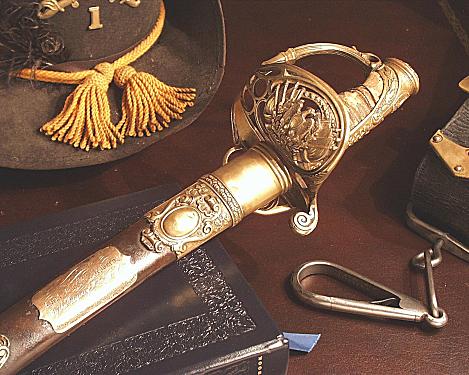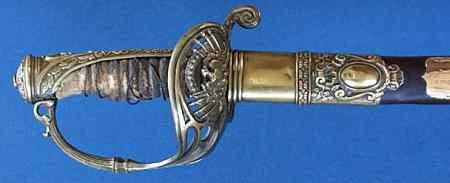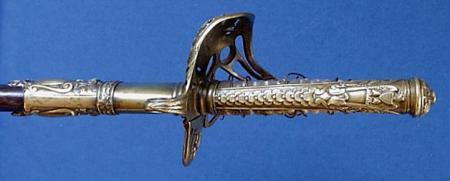|
James Hepburn
|

|
| This non-regulation cavalry saber has the following inscription on
the gold plate attached to scabbard above the top mount in script letters:
Presented June 1865 to Lieut. James W.
Hepburn. By the Citizens of Mokelumne Hill and Vicinity. As a token of their appreciation of his Services while a
Soldier in the Army of the POTOMAC. |
James Worthington Hepburn was born January 9, 1838, the son of James Hepburn
and Rebecca Cowden and the youngest of six children. His forbears originated
in Scotland, but had established their homestead in Pennsylvania in the
1750's and since then resided in Williamsport, Lymcome County, lush farm
country with low rolling hills and well painted barns.
By the time James was 25 years old and the Civil War hostilities began, he
was living in the West while trying his luck in the gold fields of
California. James was a tall young man for the time at 5'8 ½" with light hair
and blue eyes. And it seems he was ready for a fight.
James was among the second wave of enlistees to join the group of
Californians headed for Massachusetts, eventually to enter the war as part of
the Cal Battalion, formally of E Company of the 2nd Mass Cavalry.
The 2nd Mass soon participated in numerous scouts, expeditions, and
skirmishes which included South Ana Bridge, Hanover Court House, Ashby's Gap,
Fairfax Court House, and Leesburg, Virginia. These small engagements and
skirmishes gradually whittled away at the muster rolls on both sides. On
August 24, 1863 Pvt. Hepburn's E Company was escorting 100 horses past
Gooding's Tavern when they were surprised by Mosby and
about 30 of his men. A hot skirmish took place and two men from both sides
were killed, five 2nd Mass troopers were taken prisoner and 75 horses were
lost to the partisan rangers. But the 2nd Mass troopers had helped even the
score by seriously wounding Col. Mosby in the side and thigh.
Pvt. Hepburn remained with the unit throughout 1863 and 1864. In October of
1864 he was among the troops who were surprised by Confederate General Jubal
Early's attack at Cedar Creek. The desperate struggle included Union cavalry
charges into the Confederate lines of infantry. As the two lines crashed
together during one of these clashes, Sergeant Hepburn received a bullet
wound to his head which bled profusely, although he was to survive the day's
severe fighting.
By 1865 and as the Army of Northern Virginia was coming to bay at Petersburg,
Sergeant Hepburn received the news that he was to be honorably discharged
from his service with the 2nd Massachusetts, in order to return to California
and accept a commission as a 2nd Lieutenant in the California Cavalry. His
time of service in the Civil War had drawn to a close.
On July 8, 1865 Independence Day festivities were held at Mokelumne Hill,
in Calaveras County, California. The day's celebrations included a parade,
brass bands playing "soul stirring airs in honor of the glorious event" and
orations from speaker at a stand in the center of town. A speaker took the
stand and recounted the honorable service of Lieutenant Hepburn and the men
of the Cal Battalion. He concluded his remarks thusly:
"Sir, it is as a token of our appreciation of the services which have
upheld the glory of our flag, and vindicated the cause for which our fallen
brethren laid down their lives, that I, in behalf of the Citizens of
Mokelumne Hill, present to you this sword.
Take it, wear it as a memento of the respect and love which we shall
always cherish toward you, and if need be, use it in the service of your
country. Should foreign tyrants wish to share in the humiliation of domestic
traitors let us hope that this sword will write up as bright and enduring a
record as that other which flashed and triumphed upon the battle fields of
the rebellion."
Lieutenant Hepburn then took the podium and gave this stirring yet concise
reply:
"Captain Hopkins and Gentlemen: The army is a poor school in which to
learn the arts of oratory, and I cannot find words to express my feelings of
gratitude to my old friends of Mokelumne Hill for their noble gift which you
have just presented me. Whatever may be the sum of the services I have
rendered to our country in the war which has just closed, and whatever the
peril incurred, thousands and hundreds of thousands of others have freely
done the same. And in the future we may be sure of this: that our country
will ask no service of any of her sons which myriads will not cheerfully
volunteer to perform.
This gift - the precious token of esteem from my old friends - will ever
be most dear to me; and I shall endeavor that no act of mine shall ever
disgrace it, or its donors. - Through you, sir, I tender to them my thanks,
My debt of gratitude I cannot express, and never can repay."
At the conclusion of his remarks, the crowd gave three rousing cheers,
after which a rendition of "When Johnny Comes Marching Home" was played,
followed by a benediction offered by Reverend Pierpont and Lieutenant took
his step into history.
Biography courtesy of Mike Sorenson
 |
 |
| Cast brass guard with outstanding winged
eagle surrounded by oak leaves and panoply of arms and banners. Top of grip
and pommel are cast brass, heavily decorated with eagle and leaf design on
stippled field showing very little wear. Backstrap has knurled finial at
center and at slot for saber knot. The sharkskin grip is 50% intact with
remains of wire wrap still present but not attached. The counterguard folds
against scabbard. European import single edged blade is 35 ½" and is marked
"W. Clauberg/Solingen" at ricasso with Iron Proof on top of blade and
importer's name "Schuyler Hartley & Graham, New York". Blade is semi-bright
with perfect age patina, minor pitting at tip. Etched motifs in 6" pattern
at center of blade is swept eagle over E Pluribus Unum banner, other side
"U.S." with intricate scrolls, very sharp lines.
Metal scabbard is frosted brown surface with 95% remaining.
Intricate cast brass mounts are heavily decorated with scrolls, leaf designs
and panoply of arms. Gold
plate with inscription is mounted between mount and top cap. |
|


